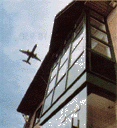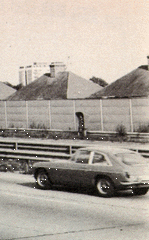Noise
Noise Sources
Noise is usually from transportation systems - trains, planes, and automobiles. On most sites, the Planning Policy Guidance note 24: Planning and Noise (PPG24) is used to decide the appropriate action for a noise level on a site.
PPG24 suggests that typical noise levels should be determined for all hours of the day and night. These levels are then sorted into four bands or Noise Exposure Categories. Each category suggests appropriate actions, from recommending that adequate noise protection is provided, to recommending that the local authority refuse planning permission.
Solutions
Before possible solutions are discussed in any detail, the noise levels existing on the site should be determined. Usually, this is best done by direct measurement - deploying sound level meters around the site for a long enough duration to be able to comment on the 'typical' noise levels at various locations on the site. The detail and confidence of the comments can be limited if a survey duration (and cost) is limited.

Noise from road sources can be predicted using traffic flow data. There is some discussion as to whether prediction is better than a sample day noise monitoring (is the day of the survey is particularly typical? how accurate is the prediction?). The one advantage of the prediction method is that it does not require access to the site, and could therefore be undertaken prior to purchase of a site. Foreknowledge of the kind of noise protection that may be required may be useful to avoid buying a blighted site in ignorance.
Double Glazing
Double Glazing is a very common, and effective, solution to noise in housing developments. It is important to bear in mind that a partially open window offers little more attenuation than no window at all. If the noise protection of high specification glazing is to be maintained, the windows must remain shut, and ventilation must be provided by another means. Glazing and ventilation manufacturers should be able to discuss the noise performance of their systems.

Noise Barriers
Road and rail sources can be effectively attenuated by barriers. The effectiveness tends to depend on how high the barrier is and how close to the source the barrier can be. Sometimes, barriers are not a possible solution. For example - a site with an express train line at one boundary. A barrier answers the local authority's concerns over noise, but the barrier will have to 4 m high and so raises new objections to the development. Effective barriers have no holes in them. Therefore, trees and shrubbery are not very effective as noise barriers, but not being able to see a noise source can reduce the number of complaints about it (also background noise level is increased due to wind moving through trees, birdsong etc).
Rearrangement of Rooms
The guidance of PPG24 applies to habitable rooms and gardens. Therefore, it is not necessary to provide the same extent of noise protection to a bathroom or kitchen, as one would to a bedroom or living room. If houses can be arranged with noise sensitive rooms facing away from a road or railway, then the noise protection measures in terms of glazing and/or barriers, may be less onerous.
Gardens
It is important to realise that the Noise Exposure Categories in PPG24 apply to the gardens of the houses as well as the facades of the houses. Gardens in noisy areas of sites can only be protected by barriers - which can lead to a dark, unappealing garden if the barrier has to be quite high. A more useful solution can be to orientate the garden relative to the house such that the house is between the noise source and the garden. (This may not be possible when dealing with aeroplane noise sources.)
Different categories can exist on the same site. Sometimes, a rearrangement of the site layout can solve some problems. For example, moving car parking or landscaping into an area where noise control is either not possible to too onerous can free better quality land elsewhere on the site for housing.

